As the daylight starts to fade, two hikers huddle under a tree somewhere in the wilderness of Beus Canyon, Utah. What started as a simple day hike has turned into a desperate situation. For hours, these two have been searching for a way out. They are cold, they are lost, and the sun is setting fast. Suddenly, the familiar buzz of a drone appears overhead. That sound, normally an irritating reminder of the gradual encroachment of technology into nature, now comes as a welcome relief. After hours stuck in the steep, snowy cliffs, Weber County Search and Rescue has come to bring these hikers home.
Stories like this are becoming increasingly common as more Search and Rescue (SAR) teams use drones to locate missing persons, scan terrain for accessibility, and view hard-to-reach areas during a search.
Having an eye in the sky is useful, but it’s only half the battle. One thing immediately becomes obvious once you start using drones to find people in a wilderness setting: It’s harder than you’d think. People often appear as tiny blotches of pixels, partly obscured by foliage, in an environment that is full of different objects and colours. For a human scanning over these images, it is very easy to miss things that may be critical to the search.
As one SAR-drone operator put it:
You’re looking for “just-noticeable differences” - things just on the edge of your perception
Take this image for example, taken from a drone east of Albuquerque, New Mexico. This image contains a person. Give yourself 10 seconds to find them.

If you found them, congratulations, you’re better than most! If not, don’t worry, you’re in good company, and you will find the answer at the end of this article.
This gives just a glimpse of the difficulty that SAR drone-operators face. In a real operation, the operator may have to scan through video like this for hours at a time, not even knowing whether the subject is there in the first place.
Enter computer vision. In the last few years, a number of tools have been developed to scan drone images and videos for objects of interest during a search and rescue operation.
In this article - we will give a brief introduction and comparison of currently available tools for drones in search and rescue to help locate missing persons: Loc8, Searchlight, SARUAV, and of course - Eagle Eyes. These are just the commercial tools available now - there are a whole slew of experimental prototypes from the academic literature, and those might just be the subject for another article one day.
Before we start, a disclaimer: As the author of one of these tools (Eagle Eyes), I cannot claim to be unbiased. However, I do my best to give everyone a fair shake in this post - we are after all working towards the same objective: To help Search and Rescue teams to find people more effectively. If any of the publishers or users of these tools spot any inaccuracies, feel free to reach out to info@eagleeyessearch.com, and I will correct them.
The Lineup
Let’s introduce the contenders.
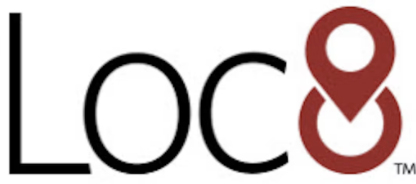 |
Loc8 is a software tool that scans through drone images for small objects of particular colours. It is probably the most widely used computer vision tool by SAR teams today. |
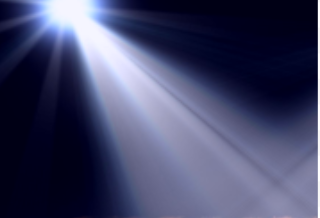 |
SearchLight is an online tool to which you can submit images for scanning. It uses an object-detection model that looks for people, crashed aircraft, vehicles, etc. in images. |
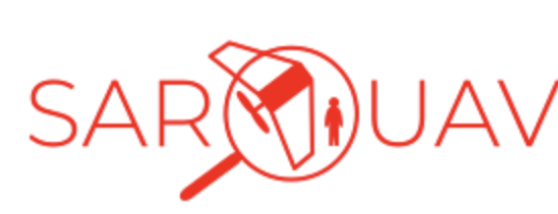 |
SARUAV is a startup that emerged from a 7 year industry-university co-op in Poland. The tool has been used by a few SAR teams in Poland and Germany, and may be behind the first successful rescue of a person using a computer vision system. It uses a deep “object-detection” based approach similar to Searchlight. |
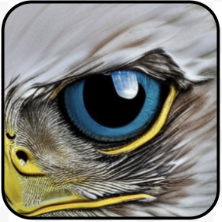 |
Eagle Eyes is a new tool on the market. It finds small “unusual” objects in both live streaming video from the drone, and recordings after the fact, using colour and motion. It consists of Eagle Eyes Pilot - a drone-piloting app with live detection, and Eagle Eyes Scan - a tool for detection on video/images. |
The Basics
| Feature | Loc8 | SearchLight | SARUAV | EagleEyes |
|---|---|---|---|---|
| Input format | Images | Images | Nadir Images | Images/Videos |
| Live detection while flying | ❌ | ❌ | ❌ | ✅ |
| Thermal | ✅ (with RDT kit) | ❌ | ❌ | ⏳ |
| Works offline | ✅ | ❌ | ✅ | ✅ |
| Platform | Windows | Web Browser | Windows | Windows/Mac/Android |
| Approach | Colour-Filter | Deep-person-detection | Deep-person-detection | Colour/Motion-Anomaly |
| Cost (USD/year) | $699 / $1199 (Visual/Visual+Thermal) |
$588 / $1140 (Non-profit / profit) |
(Unknown: contact them) | Free during alpha-testing |
Input format
All of these tools can take set of images as input. SARUAV specifies that these images should be in the “Nadir” view - (ie looking down). Eagle Eyes also accepts videos.
For Search and Rescue purposes, a collection of overlapping images is often better than videos. Images usually have higher resolution, meaning it’s possible to see smaller or more distant objects. Moreover, the standard 30 frames per second of video is often more than necessary to capture what needs to be seen - good coverage of each point on the terrain from a few different viewpoints.
However there are a few advantages to video. For one - motion can be a powerful cue when the subject is conscious and able to move. They may be walking or waving in response to the sound of the drone. This is especially important when the colours that the person is wearing are similar to the colours of the surrounding terrain.
A second advantage of video comes when flying over forest or dense foliage. In these cases, you often get only very brief glimpses of things under the tree canopy. With video, you are much more likely to capture these fleeting glimpses than with a series of images spaced several seconds apart.
Live Detection while Flying
Of these tools - only Eagle Eyes offers live detection while flying. You operate the drone as normal, using the Eagle Eyes Pilot app on your mobile device. The app displays the live video feed, along with boxes around any objects deemed sufficiently “unusual” by the computer vision system.
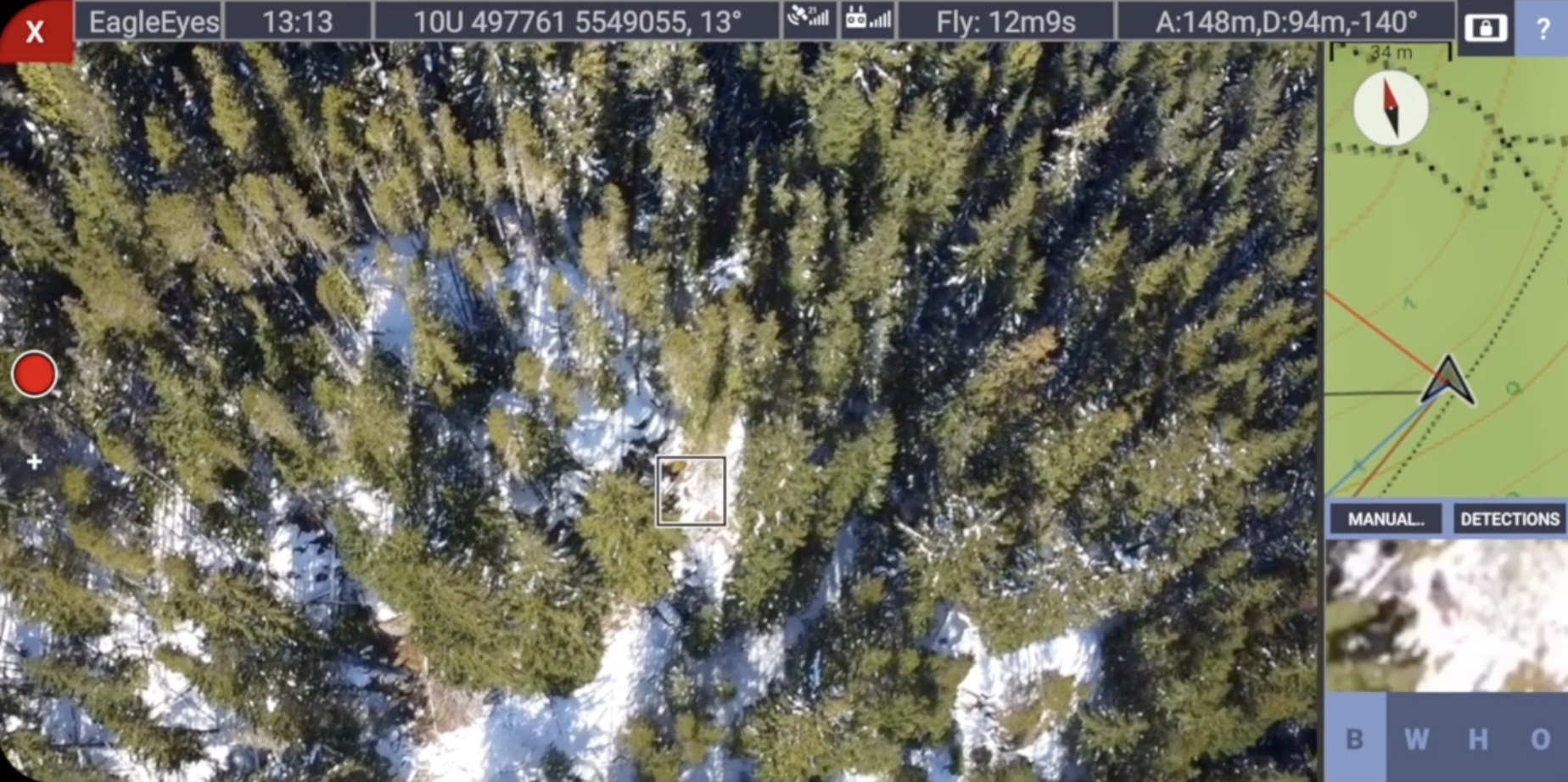
The Eagle Eyes Pilot app shows a detection box over the live video feed.
Here, the app detects a test dummy based on the red snowpants.
Thermal
Thermal imagery can be a powerful tool for SAR, but its usefulness greatly depends on environment. It performs best on cold, cloudy days, when there is little temperature variation in the environment, and the body heat of a person stands out clearly. It can be nearly useless in hot, sunny environments, where the temperature variation between hot rocks and cool shadows can easily drown out the heat signature of a person.
Unmanned Systems Research (the creators of Loc8) have also released the Radiometric Data Toolset (RDT) , a separate tool for detecting people (and in general, warm objects), in thermal imagery, by looking for small patches of heat. It scans through thermal images collected from DJI M300 or M30T drones.
Eagle Eyes allows the user to view thermal imagery both live via the piloting app, and after the fact in the video recording. It allows the user to easily switch between visual and thermal imagery to verify a suspected detection in one modality against the other. At time of writing, Eagle Eyes does not yet do automatic detection from thermal imagery, but it is in the pipeline.
| Loc8 (RDT Kit) | Eagle Eyes |
|---|---|
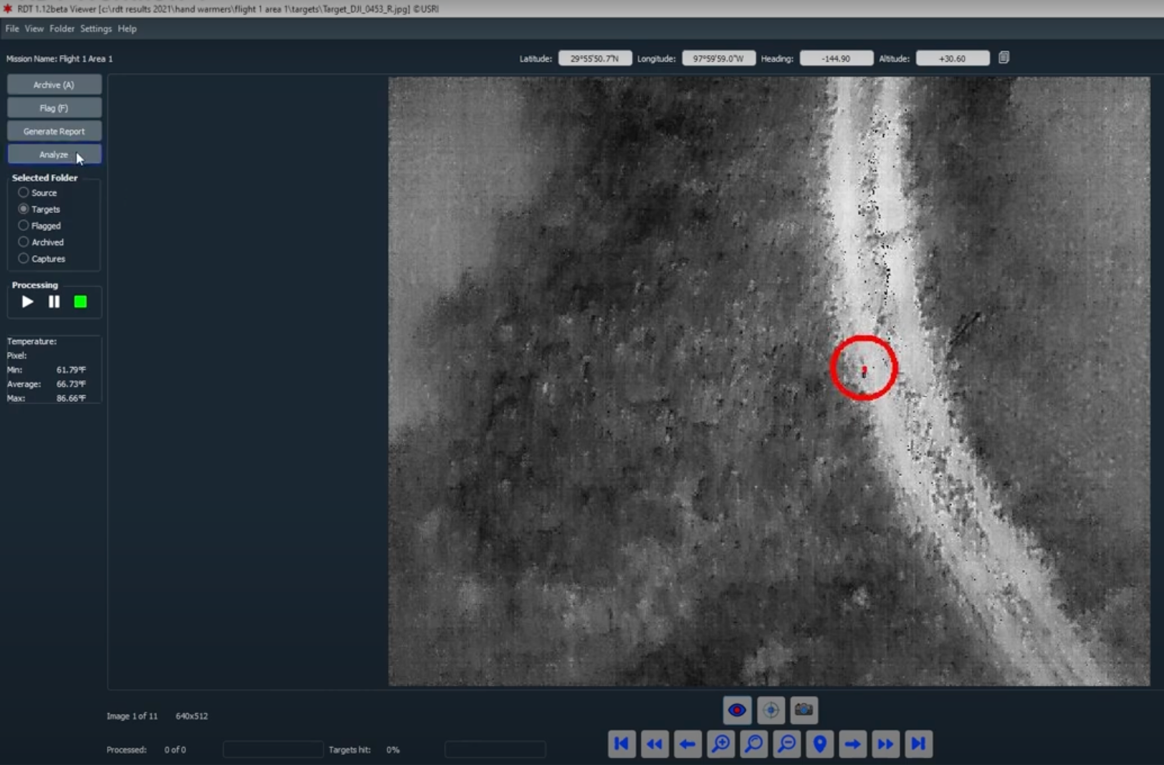 |
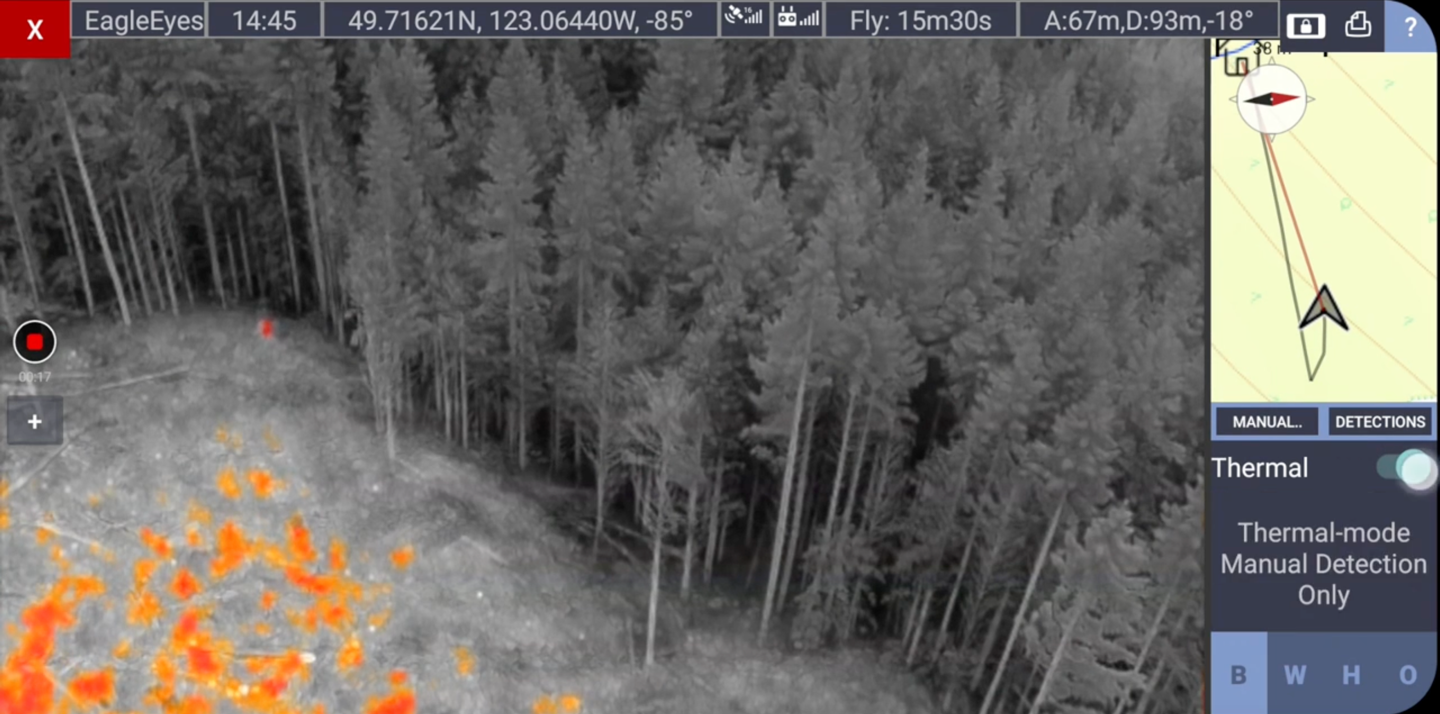 |
| A screenshot from Loc8’s Radiometric Data Toolset, showing the detection of a hand-warmer packet. | Eagle Eyes Pilot showing displays thermal imagery from a DJI ME2 Thermal Drone. The heat-blob near the edge of the forest is a person. |
Platform
Searchlight is a web-based tool, and can be used on any platform with a web browser, but requires an internet connection.
Loc8 and SARUAV are Windows-only tools.
Eagle Eyes Scan, the tool from Eagle Eyes for scanning through recorded images and video,
is available for MacOS and Windows.
Eagle Eyes Pilot, the tool from Eagle Eyes for piloting drones is available for Android devices
Offline Detection
In Search and Rescue - offline operation is important. SAR teams are often operating far from urban centers, or in areas where mountainous terrain makes for poor cell signal. Of the above tools, only Searchlight requires an internet connection. In Searchlight you upload images to an online portal for processing.
Approach to Detection
In this section I’ll go over the general approach to detection taken by each tool, and link to a video demo from each tool’s creator - providing a sprinkling of my own commentary at the end.
Loc8
Loc8 is based on colour-filtering. In the original version, you specify a “box” in colour space, either using a colour-picker or providing a sample image (e.g. a cropped image of blue jeans, showing a sampling of the shades of blue that one might expect to find.). A more recent “G2” version adds the “Multichannel Dynamic Algorithm Search” (MDAS) which allows for multiple colour filters to be run in parallel, meaning you don’t need a prior idea of what colour to look for (though it helps to have one).
Comments Unlike the other tools here, Loc8 provides a lot of “knobs” that the operator can tune when deciding what to search for. This can be a strength, especially when you know what colour you’re looking for (e.g. from a report of a missing person wearing a specific colour of clothing). However it can also be a distraction, especially in a time-critical situation where you don’t have time to be tweaking parameters.
That said, the tool clearly has a history of use in the field, and is currently used by several SAR teams around the world.
Searchlight
Searchlight uses a deep-learning based approach. The model has been trained on images of downed aircraft, hikers, etc. You are able to chose what type of object you are looking for, or search by colour-palette, and you can define a “confidence threshold”. The tool uses a web-based interface, where you can submit a folder of images for processing. This, as mentioned before, has the disadvantage that you need an internet connection to use it.
Comments On the plus side, the web-based interface means nothing needs to be installed on the user’s machine. However, there seems to be some significant drawbacks to this tool. First, the need for an internet connection can prevent the tool from being used in the field. Second, the need to upload images presents a legal problem for SAR teams who often are required to keep images private - as they are often property of the local police force and may be evidence in an investigation. Third is the lack of compelling demos. The images shown in the demos and website are high-res images of objects that would be easily found by eye anyway - it is not clear how the tool performs in the more realistic scenarios where the object is just a small blob of pixels in a large image.
SARUAV
This demo video shows the SAR-UAV system. It shows a mock SAR operation, where the drone is first launched to fly a path of the search area, take a series of images, then run them through the detection system.
Comments: The provided video appears to demonstrate the software being used in the field by a real SAR team. Based on this paper it appears that the software has directly contributed to the rescue of a person. However, there are few demos available online, and it is hard to judge based on the limited evidence whether SARUAV is a complete, deployable tool.
EagleEyes
Eagle Eyes scans a video-stream for colour-anomalies and isolated moving objects. The app comes in two forms. Eagle Eyes Pilot is an Android app for piloting the drone, showing detection on the live video stream, and Eagle Eyes Scan is a Windows/MacOS desktop app which runs the detection algorithm offline on recorded video. The algorithm is more of a “black box” than Loc8, presenting the user with just a single threshold to tune. It looks for colour-and-motion anomalies - things that just “don’t fit in” to the scene. Eagle Eyes presents the user with a ranked list of detections, linked to the GPS coordinates of the drone at the time of detection.
Comments: The demos make it clear that Eagle Eyes definitely finds things that would be difficult to find by eye. The tool appears to be easier to get started with than Loc8, but is less customizable, which may matter in situations where you have a specific idea of what you are looking for. Some demos show that the system also produces false-positives, which the operator needs to dismiss manually.
But how well do they actually work?
Currently, there is simply no way to make an apples-to-apples comparison between these tools. For now the best you can do is to judge for yourself based on the above videos.
The tools obviously have their various advantages and drawbacks, but at the same time, they are all performing a similar task - finding people in the wilderness - and they should be comparable in principle.
In the world of computer vision - you compare things by having a standard dataset, defining a scoring function, and then comparing the scores of different models on that dataset. Setting up a proper benchmark for comparison is a non-trivial task, with a lot of gotchas, and may well be the subject of a future blog post.
Conclusions
Loc8 is an impressive and fairly mature tool with a record of use in the field. It can require extensive tuning to work well in a given environment, but can provide impressive results when the filters are tuned appropriately.
Searchlight and SARUAV both may have use, but really need more compelling demos to show their value.
Eagle Eyes is the only tool that works live, while flying the drone, and may or may not be an improvement over Loc8 when scanning recorded images and video. While it has fewer customization options than Loc8, it appears to be significantly easier to use for scanning video.
Currently, since there is no way to do an apples-to-apples comparison between these models, you will have to try these different tools for yourself to see what suits you best. Fortunately, for Eagle Eyes - you can try it for free if you sign up as an alpha-tester. Click here to request a free trial of the Eagle Eyes software.
So where was that person?
In case you did not find the person in that picture at the top of this article - no problem, Eagle Eyes has your back:
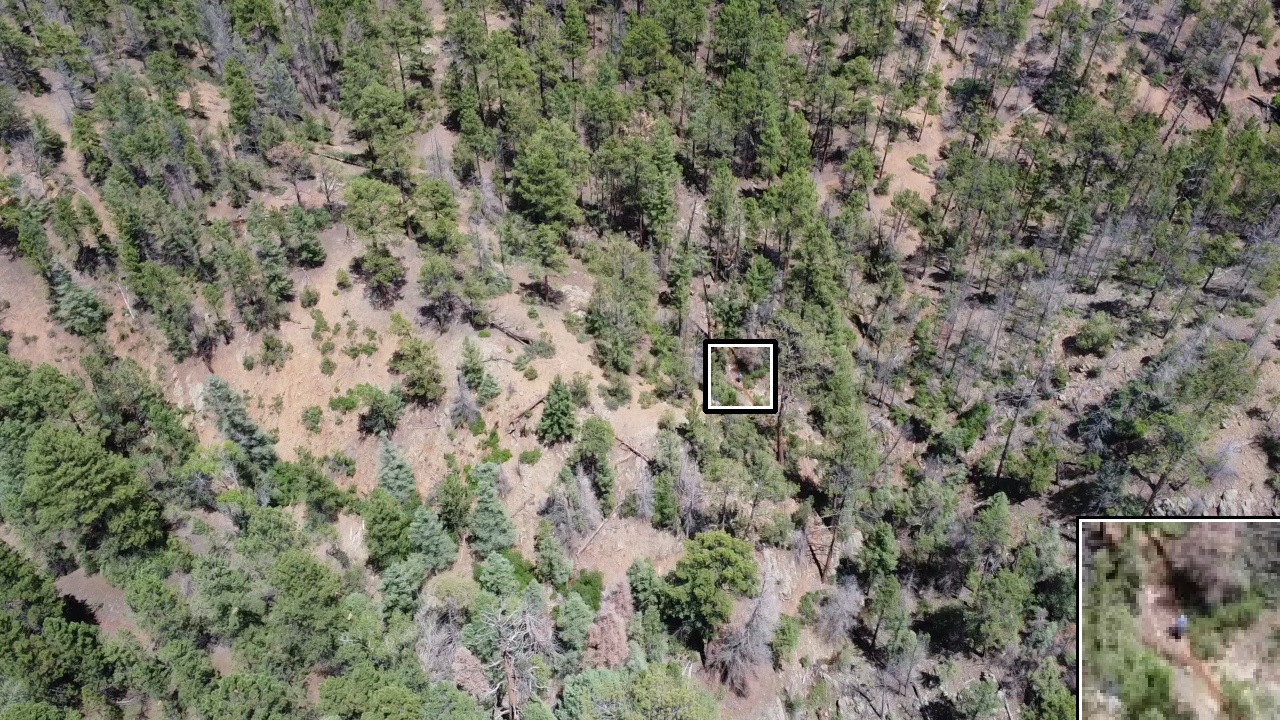
16 March 2023, by Peter O'Connor
